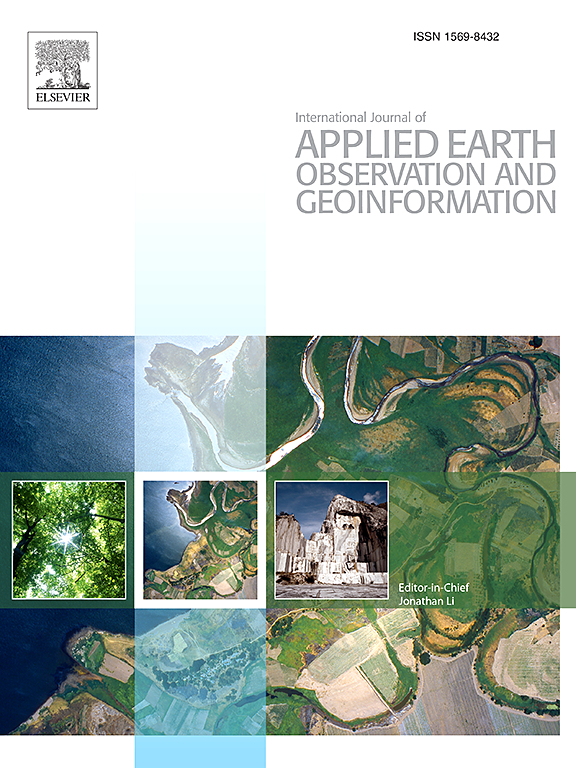基于上下文模型(SEBAL)分析兴趣区(AOI)大小和端元选择对蒸散发(ET)估算的影响
IF 7.6
Q1 REMOTE SENSING
International journal of applied earth observation and geoinformation : ITC journal
Pub Date : 2025-04-11
DOI:10.1016/j.jag.2025.104514
引用次数: 0
摘要
准确估算蒸散量对于有效的水资源管理至关重要,特别是在干旱和半干旱地区。遥感技术的进步使ET模型不可或缺,提供高分辨率的空间和时间评估。背景模型,如陆地表面能量平衡算法(SEBAL)对ET估算特别有价值。然而,这些模型面临的一个主要挑战是确定代表AOI内干湿极端的端元。此外,AOI大小对端元选择的影响为模型性能提供了重要的考虑因素。这项工作考察了AOI的大小和端元选择如何影响使用SEBAL模型的热通量估计。该研究于2022年5月至2023年4月在马拉喀什Agdal站点的一个橄榄果园进行,并于2017年8月至2019年3月在Sidi Rehal站点的一个旱作麦田进行,使用了Landsat图像(L8和L9)和ERA5土地再分析数据。为此,SEBAL应用于六个不同的AOI,范围从小而均匀的区域到陆地卫星图像的全部范围。基于SEBAL估计值与从Agdal站点收集的涡动相关数据的比较,分析表明,准确识别端元的困难受到AOI大小的影响。对于均匀区域,该模型难以捕捉热通量的全部范围,从而导致较差的回归关系。相反,应用覆盖整个Landsat图像的shapefile导致潜热通量分布更加均匀,特别是在冬季/春季(当气候需求较低时),这降低了模式捕捉空间变异性的能力。AOI包括农业地区、裸露土壤、水体和小城镇,其边界相对靠近测量站,结果最好。H和LE的R2分别为0.95和0.88,H和LE的RMSE分别为51.24和52.41 W/m2。在区域尺度上,旱作小麦地AOI大小越大,结果越差,散度越大,H和LE的RMSE值分别为104.99和93.30 W/m2。相比之下,将区域分割为AOI的最佳大小可以获得更准确的结果,H和LE的R2值分别为0.96和0.92,相应的RMSE值分别为56.9和35.88 W/m2。这些研究结果强调了AOI大小和端元识别在提高SEBAL模型精度和增强地方和区域水资源可持续管理ET估算方面的关键作用。本文章由计算机程序翻译,如有差异,请以英文原文为准。

Analyzing the impact of area of interest (AOI) size and endmember selection on evapotranspiration (ET) estimation through a contextual model (SEBAL)
Accurate estimation of evapotranspiration (ET) is essential for effective water resource management, particularly in arid and semi-arid areas. Advancements in remote sensing technology have made ET models indispensable, offering high-resolution spatial and temporal assessments. Contextual models such as the Surface Energy Balance Algorithm for Land (SEBAL) are particularly valuable for ET estimation. However, one major challenge for these models is the identification of endmembers representing the wet and dry extremes within the AOI. Furthermore, the influence of AOI size on endmember selection raises important considerations for model performance. This work examines how the size of the AOI and endmember selection impact heat flux estimation using the SEBAL model. The research was conducted in an olive orchard at the Agdal site in Marrakech, from May 2022 to April 2023, and at a rainfed wheat field at the Sidi Rehal site from August 2017 to March 2019, using Landsat imagery (L8 and L9) and ERA5 land reanalysis data. For that, SEBAL was applied to six different AOI, ranging from small and homogeneous areas to the full extent of the Landsat imagery. Based on comparisons of SEBAL estimates with eddy covariance data collected from the Agdal site, the analysis shows that difficulties in accurately identifying endmembers are influenced by the size of the AOI. For homogeneous areas, the model struggles to capture the full range of heat fluxes, leading to poor regression relationships. Conversely, applying a shapefile that covers the entire Landsat imagery led to a more uniform distribution of latent heat flux, especially in winter/spring (when the climatic demand is low), which reduced the model’s ability to capture spatial variability. The AOI, which includes a mix of agricultural areas, bare soil, water bodies, and small towns, and whose boundary is relatively close to the measurement station, yielded the best results. It achieved R2 values of 0.95 for H and 0.88 for LE, with RMSE values of 51.24 and 52.41 W/m2 for H and LE, respectively. At the regional scale, the larger AOI size produced the lowest results with greater dispersion at the rainfed wheat site, with RMSE values of 104.99 and 93.30 W/m2 for H and LE, respectively. In contrast, segmenting the region into optimal size of AOI produced more accurate results, achieving R2 values of 0.96 for H and 0.92 for LE, with corresponding RMSE values of 56.9 and 35.88 W/m2, respectively. These findings emphasize the critical role of AOI size and endmember identification in improving SEBAL model accuracy and enhancing ET estimation for the sustainable management of water resources at both local and regional levels.
求助全文
通过发布文献求助,成功后即可免费获取论文全文。
去求助
来源期刊

International journal of applied earth observation and geoinformation : ITC journal
Global and Planetary Change, Management, Monitoring, Policy and Law, Earth-Surface Processes, Computers in Earth Sciences
CiteScore
12.00
自引率
0.00%
发文量
0
审稿时长
77 days
期刊介绍:
The International Journal of Applied Earth Observation and Geoinformation publishes original papers that utilize earth observation data for natural resource and environmental inventory and management. These data primarily originate from remote sensing platforms, including satellites and aircraft, supplemented by surface and subsurface measurements. Addressing natural resources such as forests, agricultural land, soils, and water, as well as environmental concerns like biodiversity, land degradation, and hazards, the journal explores conceptual and data-driven approaches. It covers geoinformation themes like capturing, databasing, visualization, interpretation, data quality, and spatial uncertainty.
 求助内容:
求助内容: 应助结果提醒方式:
应助结果提醒方式:


